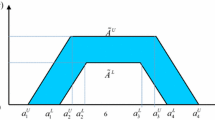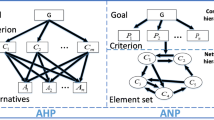Abstract
Supplier selection can be regarded as a typical multiple attribute decision-making problem. In real-world situation, the values of the alternative attributes and their weights are always being nondeterministic, and as a result of this, the values are considered interval numbers. In addition, the common approach to measure the similarity between alternatives through their distance suffers from some minor shortcomings. To address these problems, this study develops a novel hybrid decision-making method by combining the technique for order preference by similarity to an ideal solution (TOPSIS) with grey relational analysis (GRA) for supplier selection with interval numbers. By introducing the intervals theory, the extensions of Euclidean distance and grey relational grade are defined. And then a new comprehensive closeness coefficient is constituted for supplier alternatives evaluation based on the interval Euclidean distance and the interval grey relational grade, which could indicate the distance-based similarity and the shape-based similarity simultaneously. A numerical example is taken to validate the flexibility of the proposed method, and result shows that this method can tackle the uncertainty in real-world supplier selection and also help decision makers to effectively select optimal suppliers.
摘要
供应商选择属于典型的多属性决策问题。在实际应用中,备选供应商的属性取值以及属性权重 通常不是确定数值,而是具有一定的不确定性,一般采用区间数进行表达;另外,传统的采用距离测 度度量备选供应商之间相似度的方法存在缺陷。针对这些问题,论文引入区间数理论和灰色系统理论对传统理想解法进行拓展,提出一种基于灰关联分析与理想决策法的区间多属性决策方法,并用于解 决供应商选择问题。该方法构建了基于区间数的欧式距离和基于区间数的灰色关联度,通过对二者进 行有机结合构造了一种新的综合相对贴近度以实现对备选供应商的定量评价。新贴近度同时反映了备选方案与正理想方案和负理想方案之间的位置关系和数据曲线的形状关系,能够更为准确而全面地反 映方案之间的相似或相异程度。最后,通过一个数值算例对所提出的方法进行验证,结果表明该方法 能够有效解决实际不确定条件下的供应商选择问题,为决策者选择最佳供应商提供了一种新的技术途径。
Similar content being viewed by others
References
CHAI J Y, JAMES L N K, ERIC W T N. Application of decision-making techniques in supplier selection: A systematic review of literature [J]. Expert Systems with Applications, 2013, 40(10): 3872–3885. DOI: 10.1016/j.eswa.2012.12.040.
HO W, XU X W, DEY P K. Multi-criteria decision making approaches for supplier evaluation and selection: A literature review [J]. European Journal of Operational Research, 2010, 202(1): 16–24. DOI: 10.1016/j.ejor.2009.05.009.
JAIN V, WADHWA S, DESHMUKH S G. Select supplier-related issues in modelling a dynamic supply chain: Potential, challenges and direction for future research [J]. International Journal of Production Research, 2009, 47(11): 3013–3039. DOI: 10.1080/00207540701769958.
LIU B D, IWAMURA K. Fuzzy programming with fuzzy decisions and fuzzy simulation-based genetic algorithm [J]. Fuzzy Sets and Systems, 2001, 122(2): 253–262. DOI: 10.1016/S0165-0114(00)00035-X.
CHAINES A, COOPER W W. Chance-constrained programming [J]. Management Science, 1959, 6(6): 73–79. DOI: 10.1287/mnsc.6.1.73.
ABBAS M, BELLAHCENE F. Cutting plane method for multiple objective stochastic integer linear programming [J]. European Journal of Operational Research, 2016, 168(3): 967–984. DOI: 10.1016/j.ejor.2002.11.006.
EL-HAWARY M E. Electric power applications of fuzzy systems [M]. The Institute of Electrical and Electronics Engineers Press, 1998.
GOFFIN K, SZWEJCZEWSKI M, NEW C. Managing suppliers: When fewer can mean more [J]. International Journal of Physical Distribution & Logistics Management, 1997, 27(7): 422–436. DOI: 10.1108/09600039710188486.
HWANG C L, YOON K. Multiple attribute decision making: methods and applications [M]. New York: Springer-Verlag, 1981: 173–184.
BEHZADIAN M, OTAGHSARA S K, YAZDANI M, IGNATIUS J. A state-of the-art survey of TOPSIS applications [J]. Expert Syst Appl, 2012, 39(17): 13051–13069. DOI: 10.1016/j.eswa.2012.05.056.
CHEN Y J. Structured methodology for supplier selection and evaluation in a supply chain [J]. Inf Sci, 2011, 181(9): 1651–1670. DOI: 10.1016/j.ins.2010.07.026.
JAHANSHAHLOO G R, HOSSEINZADE L F, IZADIKHAH M. An algorithmic method to extend TOPSIS for decision making problems with interval data [J]. Applied Mathematics and Computation, 2006, 175(2): 1375–1384. DOI: 10.1016/j.amc.2005.08.048.
JAHANSHAHLOO G R, HOSSEINZADEH L F, DAVOODI A R. Extension of TOPSIS for decision-making problems with interval data: Interval efficiency [J]. Mathematical and Computer Modelling, 2009, 49(5, 6): 1137–1142. DOI: 10.1016/j.mcm.2008.07.009.
JAHANSHAHLOO G R, KHODABAKHSHI M, HOSSEINZADEH L F, MOAZAMI GOUDARZI M R. A cross-efficiency model based on super-efficiency for ranking units through the TOPSIS approach and its extension to the interval case [J]. Mathematical and Computer Modelling, 2011, 53(9): 1946–1955. DOI: 10.1016/j.mcm.2011.01.025.
ZHOU W K, JIANG W C. Two-phase TOPSIS of uncertain multi-attribute group decision-making [J]. Journal of Systems Engineering and Electronics, 2010, 21(3): 423–430. DOI: 10.3969/j.issn.1004-4132.2010.03.012.
OZTAYSI B. A decision model for information technology selection using AHP integrated TOPSIS-Grey: The case of content management systems [J]. Knowledge-Based Systems, 2014, 70(C): 44–54. DOI: 10.1016/j.knosys.2014.02.010.
DYMOVA L, SEVASTJANOV P, TIKHONENKO A. A direct interval extension of TOPSIS method [J]. Expert Systems with Applications, 2013, 40(12): 4841–4847. DOI: 10.1016/j.eswa.2013.02.022.
ANISSEH M, PIRI F, SHAHRAKI M R, AGAMOHAMADI F. Fuzzy extension of TOPSIS model for group decision making under multiple criteria [J]. Artif Intell Rev, 2012, 38(4): 325–338. DOI: 10.1007/s10462-011-9258-2.
TAN C Q. A multi-criteria interval-valued intuitionistic fuzzy group decision making with Choquet integral-based TOPSIS [J]. Expert Systems with Applications, 2011, 38(4): 3023–3033. DOI: 10.1016/j.eswa.2010.08.092.
BÄYÄKÖZKAN G, ÇIFÇI G. A combined fuzzy AHP and fuzzy TOPSIS based strategic analysis of electronic service quality in healthcare industry [J]. Expert Syst Appl, 2012, 39(3): 2341–2354. DOI: 10.1016/j.eswa.2011.08.061.
MOKHTARIAN M N, HADI-VENCHEH A. A new fuzzy TOPSIS method based on left and right scores: an application for determining an industrial zone for dairy products factory [J]. Appl Soft Comput, 2012, 12(8): 2496–2505. DOI: 10.1016/j.asoc.2012.03.042.
DYMOVA L, SEVASTJANOV P, TIKHONENKO A. An interval type-2 fuzzy extension of the TOPSIS method using alpha cuts [J]. Knowledge-Based Systems, 2015, 83(1):116–127. DOI: 10.1016/j.knosys.2015.03.014.
DENG J L. Introduction to grey system [J]. J Grey Syst, 1989, 1(1): 1–24.
KUO Y, YANG T, HUANG G W. The use of grey relational analysis in solving multiple attribute decision-making problems [J]. Computers & Industrial Engineering, 2008, 55(1): 80–93. DOI: 10.1016/j.cie.2007.12.002.
TSAI C H, CHANG C L, CHEN L. Applying grey relational analysis to the vendor evaluation model [J]. International Journal of the Computer, the Internet and Management, 2003, 11(4): 45–53.
LI G D, YAMAGUCHI D, NAGAI M. A grey-based rough decision-making approach to supplier selection [J]. International Journal of Advanced Manufacturing Technology, 2008, 36(9, 10): 1032–1040. DOI: 10.1007/s00170-006-0910-y.
YANG C C, CHEN B S. Supplier selection using combined analytical hierarchy process and grey relational analysis [J]. Journal of Manufacturing Technology Management, 2006, 17(7): 926–941. DOI: 10.1108/17410380610688241.
GOLMOHAMMADI D, MELLAT-PARAST M. Developing a grey-based decision-making model for supplier selection [J]. Int J Production Economics, 2012, 137(2): 191–200. DOI: 10.1016/j.ijpe.2012.01.025.
LIU S F, DANG Y G, FANG Z G, et al. Grey system theory and applications [M]. Beijing: Science Press, 2010. (in Chinese)
SUN X D, JIAO Y, HU J S. Research on decision-making method based on grey correlation degree and TOPSIS [J]. Chinese Journal of Management Science, 2005, 13(4): 63–68. (in Chinese)
TRIPATHY S, TRIPATHY D K. Multi-attribute optimization of machining process parameters in powder mixed electro-discharge machining using TOPSIS and grey relational analysis [J]. Engineering Science and Technology, an International Journal, 2016, 19(1): 62–70. DOI: 10.1016/j.jestch.2015.07.010.
WANG P, ZHU Z Q, WANG Y H. A novel hybrid MCDM model combining the SAW, TOPSIS and GRA methods based on experimental design [J]. Information Sciences, 2016, 345: 27–45. DOI: 10.1016/j.ins.2016.01.076.
CHEN M F, TZENG G H. Combining grey relation and TOPSIS concepts for selecting an expatriate host country [J]. Mathematical and Computer Modelling, 2004, 40(13): 1473–1490. DOI: 10.1016/j.mcm.2005.01.006.
XU Z, CHEN J. Some models for deriving the priority weights from interval fuzzy preference relations [J]. European Journal of Operational Research, 2008, 184(1): 266–280. DOI: 10.1016/j.ejor.2006.11.011.
SEVASTJANOV P. Numerical methods for interval and fuzzy number comparison based on the probabilistic approach and Dempster–Shafer theory [J]. Information Sciences, 2007, 177(21): 4645–4661. DOI: 10.1016/j.ins.2007.05.001.
WANG Y M, LUO Y. On rank reversal in decision analysis [J]. Mathematical and Computer Modelling, 2009, 49(5, 6): 1221–1229. DOI: 10.1016/j.mcm.2008.06.019.
CELEBI D, BAYRAKTAR D. An integrated neural network and data envelopment analysis for supplier evaluation under incomplete information [J]. Expert Systems with Applications, 2008, 35(4): 1698–1710. DOI: 10.1016/j.eswa.2007.08.107.
WANG H S, CHE Z H, WANG M J. A three-phase integrated model for product configuration change problems [J]. Experts Systems with Applications, 2009, 36(3): 5491–5509. DOI: 10.1016/j.eswa.2008.06.107.
Author information
Authors and Affiliations
Corresponding author
Additional information
Foundation item: Project(51505488) supported by the National Natural Science Foundation of China
Rights and permissions
About this article
Cite this article
Zhang, M., Li, Gx. Combining TOPSIS and GRA for supplier selection problem with interval numbers. J. Cent. South Univ. 25, 1116–1128 (2018). https://doi.org/10.1007/s11771-018-3811-y
Received:
Accepted:
Published:
Issue Date:
DOI: https://doi.org/10.1007/s11771-018-3811-y
Key words
- supplier selection
- interval number
- grey relational analysis (GRA)
- technique for order preference by similarity to an ideal solution (TOPSIS)




